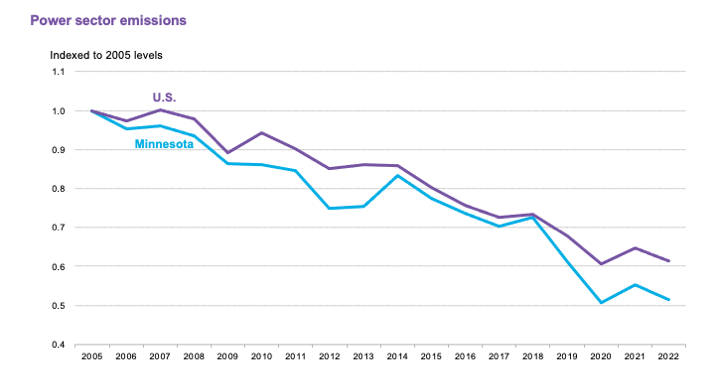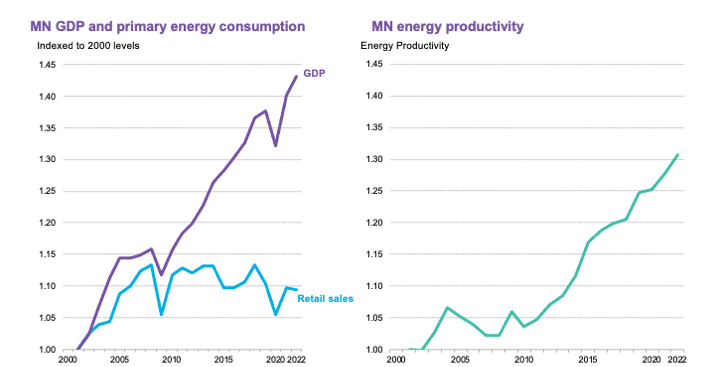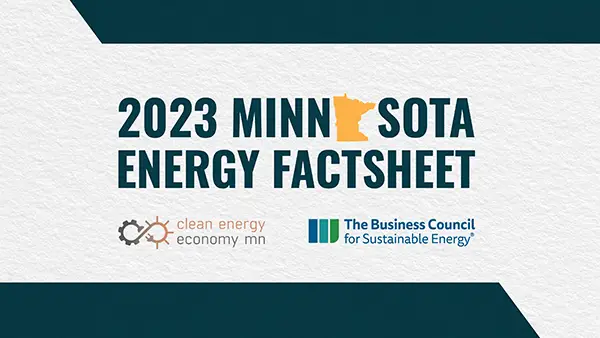By Tiffanie Connelly, Senior Manager of Communications, Clean Energy Economy Minnesota
The 2023 Minnesota Energy Factsheet reveals that the state is on track to achieve its goal of a clean energy economy. With 55% of the state’s energy coming from zero-carbon sources and a significant drop in power sector carbon emissions, Minnesota’s clean energy transition is steadily advancing every year. In this blog post, we’ll take a closer look at the 2023 Minnesota Energy Factsheet, explore the challenges and opportunities faced by the state’s energy industry in 2022, and highlight the top five takeaways from this year’s report.
The clean energy transition is locked into Minnesota’s future
Minnesota’s clean energy transition is locked in, and the state is making steady progress toward energy independence. With the majority of the state’s energy (55%) being generated from zero-carbon sources for the third consecutive year, Minnesota is well on its way to a clean energy economy. Furthermore, the state has reduced energy imports by more than half in the last decade, with just 9% of energy being imported in 2022, compared to 25% in 2013. The clean energy industry in Minnesota employs nearly 58,000 workers, and the state’s workforce is growing steadily.
Renewables are leading the state’s electricity mix

Renewables are the driving force behind Minnesota’s transition to a clean energy economy. In 2022, the state added 228MW of new wind and solar generation, and renewables made up 81% of all new capacity built in the last decade. Natural gas and oil plants accounted for the remaining capacity, as no new coal-fired power plants were built in the state in the last decade. The implementation of Minnesota’s Climate Action Framework will further promote the expansion of carbon-free electricity, with a primary goal of reducing carbon emissions by increasing renewable energy production.
The state is making progress in harmful greenhouse gas emissions reductions

Minnesota’s shift toward a clean energy economy has resulted in significant reductions in power sector CO2 emissions. Since 2005, power sector CO2 emissions in Minnesota have fallen by 50%, with a decrease of 7% in 2022 alone (nearly 35% in the last decade). This rate of reduction is faster than the U.S. average, and the state is making steady progress toward achieving its climate goals.
Minnesota is a national leader in energy efficiency

Minnesota has long been a leader in energy efficiency policy, and the state’s efforts have paid off. Over the last decade, Minnesota has seen a 31% boost in energy productivity, making it a regional leader in energy efficiency. The state’s strong policy in the Conservation Improvement Program and the Energy Conservation and Optimization Act are leading the way for the state’s continued progress in this sector.
Electric vehicles are increasing in popularity in the state

Transportation is the sector that contributes the most greenhouse gas emissions in Minnesota’s economy, making it a focus for the state’s clean energy goals. The number of electric vehicles on Minnesota roads has increased 4x since 2018 and more than 1000x since 2013. Minnesota is also investing $68 million from the bipartisan federal Infrastructure Investment and Jobs Act (IIJA) for EV charging infrastructure, and the state is creating a statewide EV plan to promote further EV adoption.
What’s next
The 2023 Minnesota Energy Factsheet shows that the state is making significant progress toward a clean energy economy. With renewable energy making up the vast majority of new energy capacity and emissions dropping, Minnesota is well on its way to achieving its climate goals. The state’s efforts toward energy efficiency and electric vehicle adoption are also paying off. Minnesota’s clean energy transition is not without its challenges, but with strong policies and continued investment, the state is making steady progress toward an equitable and sustainable future.
The 2023 MN Energy Factsheet is produced by Clean Energy Economy MN and the Business Council for Sustainable Energy, with data contributions from the American Council for an Energy-Efficient Economy, BloombergNEF, and the Minnesota Department of Commerce, and with the support of the McKnight Foundation. It provides a fact-based overview of Minnesota’s energy sector and presents key metrics and highlights recent trends.
About the author: Tiffanie Connelly is the Senior Manager of Communications for Clean Energy Economy Minnesota (CEEM). CEEM is an industry-led, nonprofit organization that provides the business voice for energy efficiency and clean energy in Minnesota.

